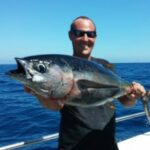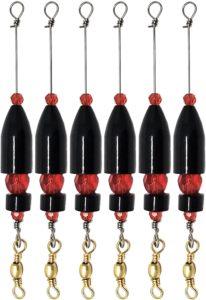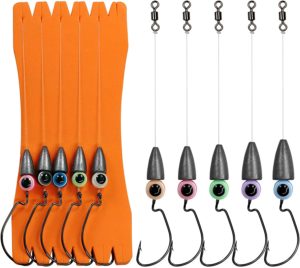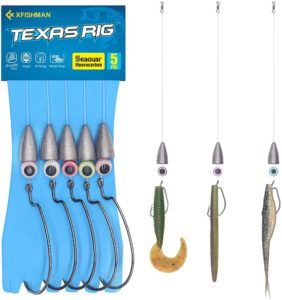Best Bait for Largemouth Bass Fishing – How To Catch More Bass

The Ever Changing Best Bait for Largemouth Bass
More fishermen lose Largemouth Bass than any other kind of fish hooked. Now I see the shuffling about, and the hands starting to come up in question or protest, but bear with me for one more moment. You see, Largemouth Bass are the most plentiful and most sought after freshwater fish. So, it only goes to reason that more of these tenacious fighting fish are lost than any other. Make sense? Well whether you’re buying into my logic or not, one thing is for certain. The best bait for Largemouth Bass can change greatly by location, and by conditions. Before we take a look at a few of the more popular methods of getting these guys to bite I just wanna let you know how annoying it is if someone doesn’t know how to pass a fishing boat.
Knowing which Bait is the Best Bait for Largemouth Bass
 The world of Largemouth Bass fishing is enormous, and can be a bit overwhelming especially for the beginner. You don’t have to be an expert at all these things to catch fish. Start with the Texas Rig, but have a few lures. Be able to switch to the Carolina Rig. Give live bait a shot with a floater. Shopping online for the products you trust can be a valuable money saving pursuit, but you also ought to consider spending some time in a local fishing store. Not a Big Name store like Walmart, but a mama and papa fishing store. Hang out and strike up a conversation. Trust me, it shouldn’t be too hard to get fishermen talking about fishing, You’ll learn tips like Largemouth can survive in warm, low oxygen water.
The world of Largemouth Bass fishing is enormous, and can be a bit overwhelming especially for the beginner. You don’t have to be an expert at all these things to catch fish. Start with the Texas Rig, but have a few lures. Be able to switch to the Carolina Rig. Give live bait a shot with a floater. Shopping online for the products you trust can be a valuable money saving pursuit, but you also ought to consider spending some time in a local fishing store. Not a Big Name store like Walmart, but a mama and papa fishing store. Hang out and strike up a conversation. Trust me, it shouldn’t be too hard to get fishermen talking about fishing, You’ll learn tips like Largemouth can survive in warm, low oxygen water.
This means you can find them close to shore in the reeds, lily beds, or other water . Or that they can spook easily from sound, and being quiet goes a long way. You can also talk to the other customers and get info on local lakes, ponds, or rivers (here are some tips for nighttime pond fishing). Find out what’s working and what’s not. Lastly, the more you practice, the better you’ll get. This will naturally result in your catching of more fish. You’ll learn the waters you fish. How the bottom is contoured, and how the fish behave during different times of the year. Slowly but surely, you’ll learn exactly what the best bait for Largemouth Bass is when you hit the water. Have a favorite setup? Maybe one I didn’t mention. Let us know in the comment section, and we’ll get right back to you. Until next time, stay fishy my friends.
If you also want to go sight fishing for spring bass, we have an article for that here.
Largemouth Set Ups and Techniques
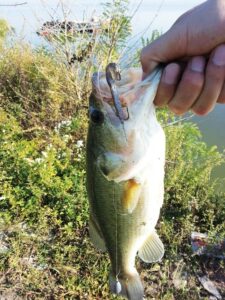 If you’re after Largemouth Bass and you’re looking to become competitive, a lot of things are going to come into play. Some people think that fishing is luck. Those of us who spend a lot of energy (time and money) doing it, know that a huge amount of skill is required to be competitive. A skilled angler can read things about a body of water that other folk wouldn’t even think to take notice of. I want to spend some time addressing that, but first the gear. I f you want to be highly successful at Largemouth Bass fishing, you’ll need to have several weapons at your disposal. You won’t want to be spending time changing your set up. You should already have several rod and reel combos (see our guide on spinning reel for bass) prepared. Each set a little differently for use in changing situations. I’d like to start by showing a few bass set ups, and finish by suggesting an arsenal of equipment that will have you ready for all conditions.
If you’re after Largemouth Bass and you’re looking to become competitive, a lot of things are going to come into play. Some people think that fishing is luck. Those of us who spend a lot of energy (time and money) doing it, know that a huge amount of skill is required to be competitive. A skilled angler can read things about a body of water that other folk wouldn’t even think to take notice of. I want to spend some time addressing that, but first the gear. I f you want to be highly successful at Largemouth Bass fishing, you’ll need to have several weapons at your disposal. You won’t want to be spending time changing your set up. You should already have several rod and reel combos (see our guide on spinning reel for bass) prepared. Each set a little differently for use in changing situations. I’d like to start by showing a few bass set ups, and finish by suggesting an arsenal of equipment that will have you ready for all conditions.
Largemouth Set Ups:
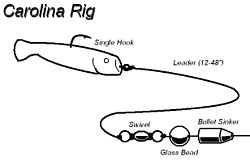 The Carolina Rig – One of the most popular rigs known. I’ve mentioned it in other articles so let’s cover it first. The Carolina Rig features a sliding weight that is stopped by a barrel swivel. A leader is then tied to the other end of the swivel, with a hook knotted to the end of the leader. The Carolina Rig can be set using different size line, weights, swivels, and hooks. It’s not uncommon for an avid bass fisherman to have 2 or 3 various Carolina Rigs set on seperate rods. The best feature of the Carolina Rig is the sliding weight. When a fish grabs your bait and pulls, the weight slides up the line preventing the fish from feeling its resistance.
The Carolina Rig – One of the most popular rigs known. I’ve mentioned it in other articles so let’s cover it first. The Carolina Rig features a sliding weight that is stopped by a barrel swivel. A leader is then tied to the other end of the swivel, with a hook knotted to the end of the leader. The Carolina Rig can be set using different size line, weights, swivels, and hooks. It’s not uncommon for an avid bass fisherman to have 2 or 3 various Carolina Rigs set on seperate rods. The best feature of the Carolina Rig is the sliding weight. When a fish grabs your bait and pulls, the weight slides up the line preventing the fish from feeling its resistance.
Carolina Rig
Catch some Largemouth bass with this Carolina rig.
Save some time and energy with this pre-rigged Carolina rigs.
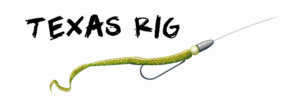 The Texas Rig – The Texas Rig may very well be the most popular way to fish Largemouth Bass. To tie a Texas Rig you’ll need a bullet weight, an off set worm hook, and the pattern or brand of imitation (or real) worm that you like. You’ll start by feeding your line through the pointed end of the bullet weight. Next, tie your off set worm hook. The basic rule for hook size is, the thicker the imitation waorm you use, the larger the hook should be. 1/0 and 2/0 hooks work well with thinner worms. 3/0 or 4/0 are better for thicker worms. Hooking the rubber worm can be tricky at first, and there are several ways to do it.
The Texas Rig – The Texas Rig may very well be the most popular way to fish Largemouth Bass. To tie a Texas Rig you’ll need a bullet weight, an off set worm hook, and the pattern or brand of imitation (or real) worm that you like. You’ll start by feeding your line through the pointed end of the bullet weight. Next, tie your off set worm hook. The basic rule for hook size is, the thicker the imitation waorm you use, the larger the hook should be. 1/0 and 2/0 hooks work well with thinner worms. 3/0 or 4/0 are better for thicker worms. Hooking the rubber worm can be tricky at first, and there are several ways to do it.
Texas Rig
Stop wasting time making Texas rigs and instead buy ready-made ones that have been proven to capture largemouth bass.
These pre-made texas rigs are made from top-quality components which you can rely on catching some largemouth bass.
Catch some Largemouth bass with this pre-made texas rig.
- Fishing the Jig – A.K.A. fishing the lure. Jigs come in so many different shapes, names, sizes, and patterns. They are sometimes used as bass lures for pond fishing. As far as setup goes, most jigs come with a built in ring to tie your line to. Most jigs are also built with weight (though some require help). The weight of a lure will usually determine if it’s meant to be used on top, or on the bottom. You should be able to simply tie your line to the lure, and be ready to fish.
- Fishing Live Bait – There are quite a few setups you could choose when it comes to fishing live bait. A couple of them stand out to me, and work in most situations. The Carolina Rig. This will work to fish the bottom, and provide enough weight for a full cast. I also like the use of a float or bobber. Floats will keep the bait closer to the top, if you don’t place them too far up the line. 6” works well. I like using floats because many you can fill part way with water to add weight for casting. They can also be bought as clear plastic which is a little harder to see than bright red or orange bobbers.
Getting acquainted with the different bass 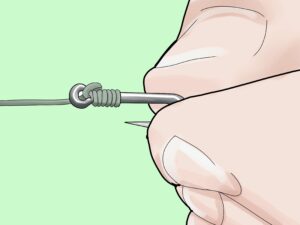 setups is an important step towards stepping up your fishing game, and leads of course directly into the knowledge and practice of using them. I feel it’s incomplete, and incorrect to name any one kind of bait the best when it comes to Largemouth fishing. It’s quite alright to have a preferred set up. I certainly do. I can’t give it away, but it’s initials are Texas Rig. The main point I want to impart to you is that on any given day, at any given time in that day, one of these setups usually works better than the others. There’s one way to know for sure, and that is to have it all with you. If you’re not competitive fishing, then you can get away with having one rod and reel. I find it’s a good idea though, to have at least 2 sets in the event of terminal tackle failure on one of your rods or reels.
setups is an important step towards stepping up your fishing game, and leads of course directly into the knowledge and practice of using them. I feel it’s incomplete, and incorrect to name any one kind of bait the best when it comes to Largemouth fishing. It’s quite alright to have a preferred set up. I certainly do. I can’t give it away, but it’s initials are Texas Rig. The main point I want to impart to you is that on any given day, at any given time in that day, one of these setups usually works better than the others. There’s one way to know for sure, and that is to have it all with you. If you’re not competitive fishing, then you can get away with having one rod and reel. I find it’s a good idea though, to have at least 2 sets in the event of terminal tackle failure on one of your rods or reels.
Largemouth Techniques:
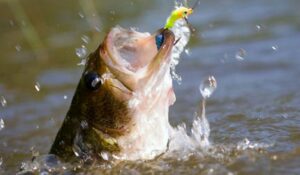 The techniques developed over the years add quite a spice to Largemouth fishing. Each setup has its own variation of methods and applications. The Carolina Rig can be used to offer live or imitation bait. You can get some distance on your cast by using the right egg weight. The Carolina can also be used when drift fishing. The Texas Rig is essential for castting into weeds without harvesting every plant in the water. As I mentioned above, live bait can be fished different ways. Then you have lures. There are so many lures; spinners, jerkbaits, swimbaits, poppers, rattlers, to name only a few. Each of these has their own style of use. Some are fished on the bottom. Some on top. The jerkbaits are jerked. So are the poppers, kind of (reeled and jerked on top). Others like rattlers and spinners have a certain action that needs to be achieved by the speed they are retrieved after cast. The list goes on and on. Referencing sites like worldfishingnetwork.com can give you some in depth details.
The techniques developed over the years add quite a spice to Largemouth fishing. Each setup has its own variation of methods and applications. The Carolina Rig can be used to offer live or imitation bait. You can get some distance on your cast by using the right egg weight. The Carolina can also be used when drift fishing. The Texas Rig is essential for castting into weeds without harvesting every plant in the water. As I mentioned above, live bait can be fished different ways. Then you have lures. There are so many lures; spinners, jerkbaits, swimbaits, poppers, rattlers, to name only a few. Each of these has their own style of use. Some are fished on the bottom. Some on top. The jerkbaits are jerked. So are the poppers, kind of (reeled and jerked on top). Others like rattlers and spinners have a certain action that needs to be achieved by the speed they are retrieved after cast. The list goes on and on. Referencing sites like worldfishingnetwork.com can give you some in depth details.
As an Amazon Associate, Fishermen's Angle earns from qualifying purchases. We get commissions for purchases made through links in this post.
